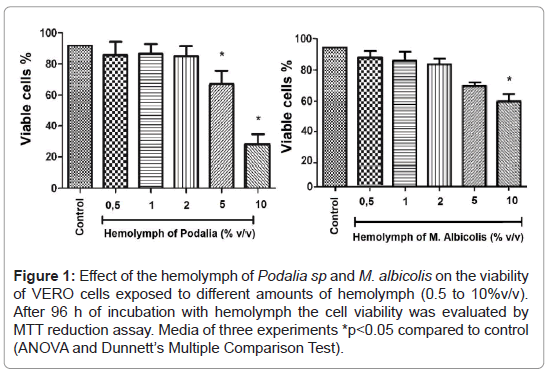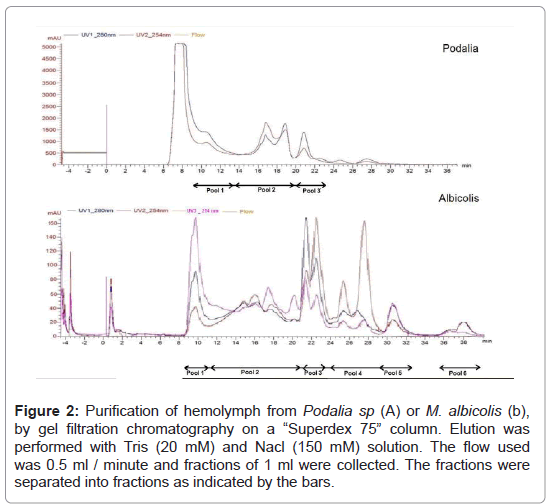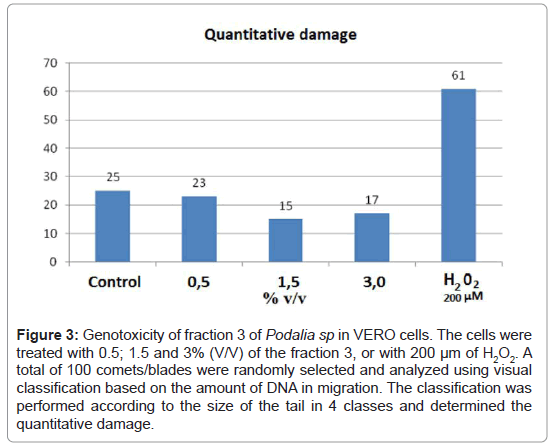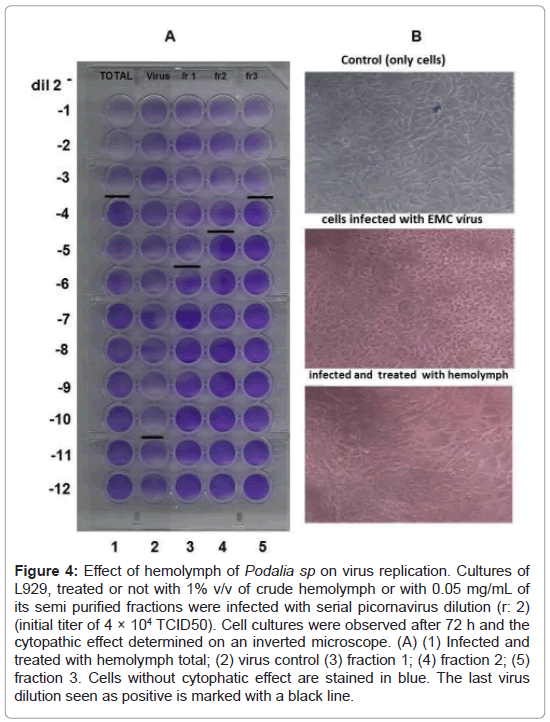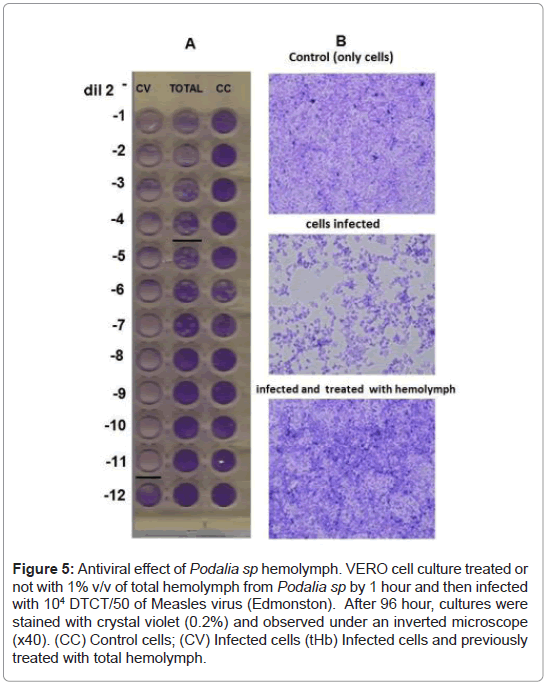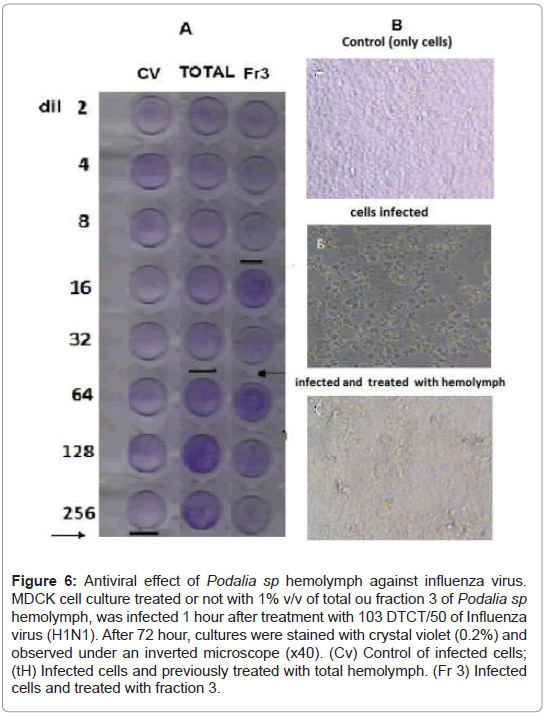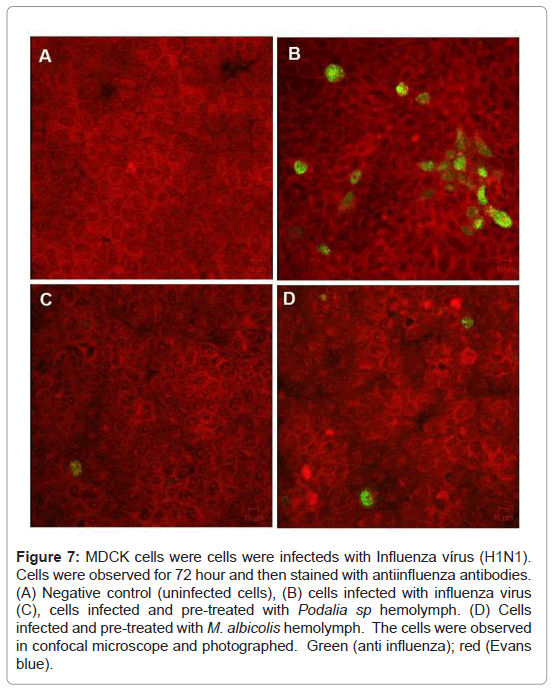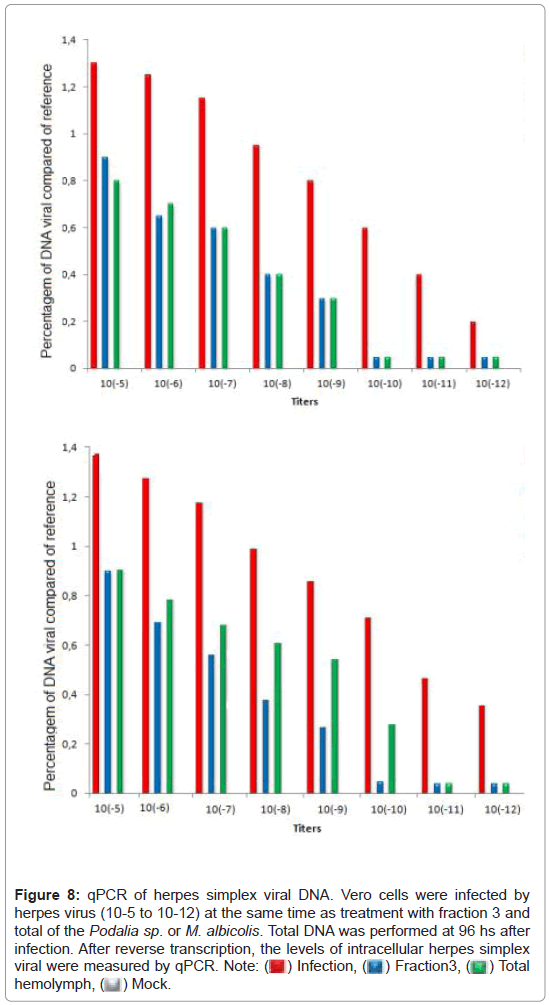Antiviral Activity of the Hemolymph of Podalia sp and M. Albicolis (Lepidoptera: Megalopigydae)
Received: 31-May-2022 / Manuscript No. JIDT-22-65437 / Editor assigned: 03-Jun-2022 / PreQC No. JIDT-22-65437(PQ) / Reviewed: 17-Jun-2022 / QC No. JIDT-22-65437 / Revised: 24-Jun-2022 / Manuscript No. JIDT-22-65437(R) / Published Date: 01-Jul-2022
Abstract
Potent antiviral activity against measles, influenza, picornavirus and herpès simplex viruses was observed in the hemolymph of Podalia sp and M. Albicolis (Lepidoptera: Megalopigydae). The antiviral proteins responsible for this activity were isolated by gel filtration chromatography using à gel filtration column system (Superdex 75) and further fractionated using a Resource-Q ion exchange column system. Experiments with the semi-purified protein led to a 128-fold reduction in picornavirus production, 64-fold reduction in measles virus production and a 32-fold reduction in influenza virus replication. qPCR showed a significantly lower level of herpes virus transcription. In addition no citotoxicity and genotoxicity effect was observed for Vero cells, suggesting a very interesting potential antiviral activity.
Keywords: Antiviral activity, Lepidoptera: Megalopigydae, Measles, Influenza, Picornavirus, Herpès simplex virus
Introduction
Viral infections cause a significant number of human diseases. While vaccine efforts have proven successful for preventing and eradicating some viral infections, many viruses can not be targeted by immunization. Other form of control include the use of antiviral drugs; Meantime, there are currently few licensed and efficacious drugs available for prophylactic and therapeutic antiviral treatments. A likely source of antivirals are the invertebrates. They do not have a developed immune system as in mammals, but the hemolymph of these artropods contains substances with potent antibacterial action virus fungal or parasitoid [1-21], infestations [22-29]. In invertebrates, the protector responses are based in the peptide with antimicrobial action [30-32], hemolymph coagulation [33], melanin formation [34], and lectin-mediated complement activation [35]. In addition to these enzyme cascades, a variety of agglutinin-lectins and reactive oxygen producing and phagocytic systems cooperate with immune reactions to kill invading pathogens [36]. Antiviral activity from insect hemolymph have also been described by Chernysh et al. [37,38]. However, antiviral defense and any interactions between antiviral and other antimicrobial defenses remain unexplored [39]. Similarly, the phenol oxidase, an enzyme obtained from the tobacco budworm (Heliothis virescens) hemolymph, was reported to exhibit antiviral activity against several vertebrate viruses in vitro (herpès simplex viruses types 1 and 2, vesicular stomatitis virus, human parainfluenzavirus 3, coxsackievirus B3 and Sindbis virus) [40]. Earlier, we have demonstrated the presence of pharmacologically active substances in the hemolymph of Lonomia obliqua with positive effect on viability and replication cell culture and on recombinant protein production describes a system for the protein expression in Sf9/baculovirus cells using the recombinant DNA to obtain a protein from the L. obliqua caterpillar that displays a potent antiviral action obtained by Greco et al. [37,41-45]. Recently, our group has studied the presence of antiviral agents in diferents animals source [38,46-51]. So, the objectives of this work were the identification and isolation of antiviral substances in hemolymph from Podalia sp and M. Albicolis (Lepidoptera: Megalopigydae).
Materials and Methods
Cells
Vero cell lines (African green monkey kidney-ATCC CCL-81), MDCK and L-929 cells were grown in 25cm2 plastic cell culture flasks or in multiwell plates using Leibovitz-15 (L15) medium containing 0.9 g L-1 of D-galactose, 0.3 g L-1 of L-glutamine and supplemented with 5% Fetal Bovine Serum (FBS). Viable cell counts were performed in Neubauer chamber using Trypan blue (0.05%) exclusion.
Hemolymph collection
The hemolymph of Podaliaspand M.Albicolis were collected from larvae after setae had been cut off. The collected hemolymph were clarified by centrifugation at 1000 × g for 10min and filtered through a 0.2 µm membrane and stored at 4°C.
Hemolymph fractionation by chromatography
After centrifugation and filtration, 1 mL of hemolymph of Podalia sp or M. Albicolis were loaded on a gel filtration chromatography system equipped with a Superdex 75 column (Amersham Pharmacia Biotech) and eluted with sodium phosphate buffer at 0.5 mL/min. The elution was monitored at 280 nm and 0.5 mL fractions were collected. The fractions were then analysed by SDS-PAGE electrophoresis.
Determination of the cytotoxic effects
The cell viability was determined by MTT assay. To this, Vero cells were cultured in 96-well plates in Leibovitz medium supplemented with 5% of fetal bovine serum. After 48h, HMG with concentrations ranging from 10 mg/mL to 0.1 mg/mL was added to the wells culture medium. After 24 hours of exposure the supernatant was discarded and MTT at concentration of 500 microgram/mL was added to the growth medium for 4 hours. After this, the culture medium was removed and 100 mL of DMSO was added. After this, the plates were shaken for 30 minutes and read on a spectrophotometer at 570 nm.
Comet test on vero cells
For analysis of possible genotoxicity caused by the hemolymph of Podalia sp, or M. Albicolis cells, Vero were treated with 1% v/v of total hemolymph or its fractions, for 24 hours.
The general procedures used in the alkaline comet test were performed as described by Singh et al. [52]. The experiments were performed in the dark to minimize any DNA damage caused by ambient light. Each preparation was photographed at a resolution of 1376 × 1032 pixels and 100 cells from each group were analyzed. Quantitative DNA damage was determined by the increase length and intensity of the comet tail corresponding to each cell.
The classification was made according to the size of the tail into 4 classes>0=undamaged; 1=little damage; 2=moderate damage and 3=full damage [53]. Comets with small or nonexistent heads and broad and diffuse tail were not included in the analysis as described by Bauer et al. [54,55].
Virus and cell infection
Measles virus (Edmonston strain), Influenza virus (H1N1), Herpès Simplex Virus (HSV-1) and picornavirus (EMC-Encephalomyocarditis virus) were used to determine the antiviral activity of the hemolymph. To this, MDCK cells were infected with 0.1 moi (multiplicity of infection) of influenza virus, Vero cells were infected with 0.01 m.o.i of measle or herpes virus and L-929 cells were infected with 0.001 m.o.i of EMC virus.
Determination of antiviral effect
To determine the antiviral effect, 96 well plates, with the different cells, were treated or not with 1% v/v of total hemolymph (Podalia sp or M Albicolis) or with 0.05 mg/mL of its fractions, 1 h prior infection. After this, the medium were removed and cell culture were infected with 100 µL of serial virus dilution (r:2) of different virus, in quadruplicates. After 1 hour adsorption at room temperature, the medium was removed and the plate replace with medium with 1% FBS. Infected and uninfected cultures, without hemolymph treatment, were prepared as negative and positive controls. All culture were incubated at 33°C. Plate cultures were observed daily for Cytopathic Effect (CPE) determination as described by Griffiths et al. [56]. Virus titers were determined by monitoring the CPE and the endpoint dilution were determined as the highest dilution of virus able to induce CPE in 50% of cells). The reduction of virus infection was determined by diference between control infected culture and the culture infected and treated with total hemolymph or its fractions. After cytopathic effect determination, the culture medium was removed and the cells in the plate were stained with crystal violet (0.2% in 20% ethanol).
Determination of antiviral activity of Podalia sp and M. albicolis against infected cells with influenza virus, using fluorescent antibodies
The protector effect of hemolymph was also determined by immunofluorescence assay. To this, MDCK cells were cultured in 96- well microplates. One hour before infection by 0,1 MOI of Influenza virus (H1N1), cells were pre-treated with 1% (v/v) total hemolymphm of Podalia sp or M. albicolis and maintained at 33°C. After 72 hours, the cells were rinsed twice with PBS and fixed in 4% paraformaldehyde (Fluka) for 20 min. After fixation, the cells were washed three times with PBS, permeabilized with Triton X-100 0.1% (Sigma) for 10 min and blocked with PBS, 1% BSA (Sigma) and 50 μg/mL RNAase A (Invitrogen) at 37°C for 1 h. After this, the cells were incubated with 10 μg/mL of mouse monoclonal anti-Influenza FITC antibody (Millipore) and with in blue evans stain, in 50 μL of PBS+1%BSA solution at 4°C overnight. The cells were washed three times with PBS containing 0.05% Tween 20 (Sigma) before incubations with 20 μg/mL propidium iodide (Sigma) in 50 μL of PBS+1% BSA for 1 h. After this incubation, the cells were washed five times with PBS+Tween 20 and 50 μL of an anti-fading solution with PBS, 50% glycerol (GE Healthcare) and ρ-phenylenediamine 0.1% (Sigma) was added to each well. The images were acquired with an confocal microscope (LSM 510 META, ZEISS).
Quantitative real-time PCR assay of cells infected by herpes virus
Total RNA was extracted from 200 µL of VERO cells culture infected by herpes virus (treated or not with hemolymph) using the MagNA Pure extractor (Roche, Basel, Switzerland). The Herpes simplex virus quantitative real time PCR assay was performed was described by Read et al. [57]. For the real time PCR, the 20 μl reaction contained 12 μl of the SYBR® Green PCR Master Mix (Applied Biosystems,Foster City, CA EUA), 10 μM of each primer, 6.5 μl H2O, and 5 μl cDNA. Cycling conditions were as follows: 94°C for 5 min, followed by 35 cycles of 94°C for 30s, 57°C for 20s and 72°C for 40s. Four positive controls containing known copy numbers of transcribed virus RNA were run on each plate as quantification standards. A reaction mixture containing water as the template was run on each plate as negative control. The data were analyzed with SDS software (version 2.1 AB).
Results
Determination of the cytotoxicity of the hemolymph
In this study, the citotoxicity properties of the hemolymph of Podalia sp and M. Albicolis were examined in VERO cells by MTT assay. As can see in the Figure 1, hemolymph concentrations lower than 2% (v/v) were not toxic to VERO cells.
Figure 1: Effect of the hemolymph of Podalia sp and M. albicolis on the viability of VERO cells exposed to different amounts of hemolymph (0.5 to 10%v/v). After 96 h of incubation with hemolymph the cell viability was evaluated by MTT reduction assay. Media of three experiments *p<0.05 compared to control (ANOVA and Dunnett’s Multiple Comparison Test).
Hemolymph fractionation by chromatography
After centrifugation and filtration, hemolymph of Podalia sp and M. Albicolis were loaded on a gel filtration chromatography system equipped with a Superdex 75 column. The results obtained are showed in Figure 2. Different chromatography perfil were obtained. Fractions of each hemolymph were harvested and storage for further tests. All fractions collected were added to cell cultures for antiviral activity determination.
Figure 2: Purification of hemolymph from Podalia sp (A) or M. albicolis (b), by gel filtration chromatography on a “Superdex 75” column. Elution was performed with Tris (20 mM) and Nacl (150 mM) solution. The flow used was 0.5 ml / minute and fractions of 1 ml were collected. The fractions were separated into fractions as indicated by the bars.
Genotoxicity of the hemolymph of Podalia SP
The determination of the genotoxic potential of hemolymph was performed by the comet method. For this, the genotoxicity of various concentrations of fraction 3 was tested in VERO cells as described in ‘‘Materials and methods’’. As positive control, the cells were treated with 200 μm of H2O2. As can be seen in Figure 3, no deleterical effect resulting from the treatment of the cells was observed. In our study, according to the classification, about 90% of comets were Class 0 (undamaged) or Class 1 (little damage) when a amount equal lower than 3% v/v was used.
Figure 3: Genotoxicity of fraction 3 of Podalia sp in VERO cells. The cells were treated with 0.5; 1.5 and 3% (V/V) of the fraction 3, or with 200 µm of H2O2. A total of 100 comets/blades were randomly selected and analyzed using visual classification based on the amount of DNA in migration. The classification was performed according to the size of the tail in 4 classes and determined the quantitative damage.
Antiviral activity of the hemolymph on the replication of the picornavirus (EMC)
To verify the effect of hemolymph on picornavirus replication, cultures of L929, treated or not with total or with semi purified fractions of Podalia hemolymph, were infected with serial dilution (r:2) of picornavirus (initial titer of 1 × 104 TCID50). In the culture infected, the hemolymph as able to reduce in 7 dilution the virus titer (Figure 4a). In the Figure 4b, in showed the cell aspect in dilution 1/1024, in infected and non infected. Nevertheless, when the same procedure was performed in culture treated with hemolymph, cytopathic effect (CPE) was observed only until dilution 1:8 to fraction 3, showing that hemolymph of Podalia sp was able to inhibit the virus replication by 128-fold. Nevertheless, when no infected culture was pre-treated with hemolymph, no adverse effect in the cell culture was observed, and it remained highly viable (data not showed).
Figure 4: Effect of hemolymph of Podalia sp on virus replication. Cultures of L929, treated or not with 1% v/v of crude hemolymph or with 0.05 mg/mL of its semi purified fractions were infected with serial picornavirus dilution (r: 2) (initial titer of 4 × 104 TCID50). Cell cultures were observed after 72 h and the cytopathic effect determined on an inverted microscope. (A) (1) Infected and treated with hemolymph total; (2) virus control (3) fraction 1; (4) fraction 2; (5) fraction 3. Cells without cytophatic effect are stained in blue. The last virus dilution seen as positive is marked with a black line.
Antiviral activity of the hemolymph on the replication of the measles
The same routine above was followed as in the experiment with the Measles virus. After 96 h post-infection with measles, a sample was taken from each culture and titrated on 96-well plates to determine virus titers. When 1% hemolymph was used in the infected culture, a reduction of virus replication was 128 folder higher than observed in m control of infected culture (Figure 5).
Figure 5: Antiviral effect of Podalia sp hemolymph. VERO cell culture treated or not with 1% v/v of total hemolymph from Podalia sp by 1 hour and then infected with 104 DTCT/50 of Measles virus (Edmonston). After 96 hour, cultures were stained with crystal violet (0.2%) and observed under an inverted microscope (x40). (CC) Control cells; (CV) Infected cells (tHb) Infected cells and previously treated with total hemolymph.
Antiviral activity of the hemolymph on the replication of the influenza
The same routine used above was followed to determine the effect of Podalia hemolymph against influenza virus (H1N1). MDCK cells pretreated with whole hemolymph of Podalia sp (1% v/v) or with 0.05 mg/mL of it fraction 3, were infected 1 hour after treatment with H1N1 vírus. As shown in Figure 6, the amount of virus produced in cultures supplemented with 1% whole total hemolymph and fraction 3 was approximately 32-fold lower than that obtained in the control infected culture. Cell cultures were observed after 72 h and the cytopathic effect determined on an inverted microscope (Figure 6).
Figure 6: Antiviral effect of Podalia sp hemolymph against influenza virus. MDCK cell culture treated or not with 1% v/v of total ou fraction 3 of Podalia sp hemolymph, was infected 1 hour after treatment with 103 DTCT/50 of Influenza virus (H1N1). After 72 hour, cultures were stained with crystal violet (0.2%) and observed under an inverted microscope (x40). (Cv) Control of infected cells; (tH) Infected cells and previously treated with total hemolymph. (Fr 3) Infected cells and treated with fraction 3.
Determination of antiviral action of Podalia e M. albicolis hemolymph by Imunofluoresce assay
To determine the antiviral effect of hemolymph against vírus da Influenza H1N1, MDCK cells were pretreated with hemolymph of Podalia sp or M. Albicolis. 1 hour after, cells were infected or not with Influenza vírus H1N1. Infected cells were observed after 72 hours of infection and then stained with specific anti Influenza A antibody (green) or Evans blue (red). Imunofluoresce of the cultures were observed by confocal microscopy. Can be observed at Figure 7, a significant reduction of virus focus can be observed to both hemolymph.
Figure 7: MDCK cells were cells were infecteds with Influenza vírus (H1N1). Cells were observed for 72 hour and then stained with antiinfluenza antibodies. (A) Negative control (uninfected cells), (B) cells infected with influenza virus (C), cells infected and pre-treated with Podalia sp hemolymph. (D) Cells infected and pre-treated with M. albicolis hemolymph. The cells were observed in confocal microscope and photographed. Green (anti influenza); red (Evans blue).
Determination of antiviral activity of the hemolymph Podalia sp e M. albicolis by qPCR
To identify any inhibitory effect of Podalia sp and M. Albicolis on vírus replication, the synthesis of herpes vírus was compared in infected cells, treated and not with fractions of Podalia sp and M. Albicolis. Total DNA extraction was performed at 96 hours after herpes infection, and the levels of intracellular herpes were measured. A standard curve for the amplification of both viruses was generated by a serial 10-fold dilution of the template to evaluate the efficiencies of both reactions. The resulting standard curves showed that the amplification efficiencies for the genes were between 95% and 100% with correlation coefficients greater than 0.99. The results of the qPCR showed a significantly increased level of herpes transcription in the inoculated cells at 4 days after viral infection compared to the mock. Was observed also that the total hemolymph and fraction 3 of the Podalia sp inhibit the replication of herpes virus (Figure 8). No reduction on vírus replication was observed witg others fractions. (Data not showed).
Figure 8: qPCR of herpes simplex viral DNA. Vero cells were infected by
herpes virus (10-5 to 10-12) at the same time as treatment with fraction 3 and
total of the Podalia sp. or M. albicolis. Total DNA was performed at 96 hs after
infection. After reverse transcription, the levels of intracellular herpes simplex
viral were measured by qPCR. Note:  Total hemolymph,
Total hemolymph,  Mock.
Mock.
Discussion
The cytotoxicity is caused by changes in cellular homeostasis that interfere with the capacity of the cells and their survival, their proliferation and the metabolic performance of their duties [58]. In this study, it was found that the whole hemolymph of Podalia sp at concentrations below 5% and its purified fractions within the range of concentrations tested have no deleterious effect on VERO cells. Petricevich et al. have carried out studies to identify substances with antiviral activity. These authors stress the importance of the identification of agents that show no toxicity to cells so that their application is feasible [12,59-61].
Various studies have reported the antiviral activity in products obtained from invertebrates. Cherrnysh et al. have isolated two antiviral and antitumoral peptides from hemolymph of Calliphora vicina, which control viral infection when added before infection [16]. Alloferon, one of the protein isolated was effective against Influenza virus A e B. it due na intracelular action similar to interferon from vertebrate, inducing a intracellular response before the viralinfection [16]. Olicard et al. showed that hemolymph of Crassostreagigas inhibits HSV-1 replication in infected vero cell culture [12]. The hemolymph of H. virescens larvae reduced the titers of the baculovirus HzSNPV Popham et al., as well of herpes simplex virus types 1 and 2, vesicular stomatitis virus, parainfluenza-3, coxsackie B3, Sindbis virus,and HIV-1 [39,40,61,62]. By the other hand, extracts of crustacean tissues have showed a broad spectrum of antiviral activity against enveloped and non-enveloped DNA and RNA viroses. This can be due to multiple inhibitors presente in the extracts [63]. Peptides derived from scorpion venom showed virucidal activity against measles, SARS-CoV and influenza H5N1 viruses and HIV-1 [64,65]. Dang et al., demonstrated that the total hemolymph and lipophilic extract of the digestive gland from abalone H. laevigata has activity against herpes simplex virus [14]. Salas-Rojas et al., showed that the coelomic fluid of the sea urchin Tripneustes depressus has antiviral activity against Suid herpesvirus type 1 (SHV-1) and rabies virus (RV) [66]. A peptide derived from mastoporan has showed a broad-spectrum antiviral activity against enveloped viruses [67]. Other peptide, isolated from a marine sponge Petromica citrine, has showed an antiviral activity of against bovine viral diarrhea vírus [68]. Lima-Netto et al., observed the antiviral effect of eggs wax from tick Amblyomma cajennense against influenza and picornavirus, for influenza virus, in this case, an amount as small as 12 µg/mL from a crude suspension of egg wax was able to reduce in 128 UHA (hemaglutinant unit) of influenza virus (H1N1) [46]. With picornavirus, this reduction was of 256-fold. Our group have purified an antiviral protein of approximately 20KDa from hemolymph of Lonomia obliqua; when added to cultures 1h before infection, this protein led to a 157-fold reduction in measles virus production and a 61-fold reduction in polio virus production [37]. It has been suggested that it may act in the stages of the replication cycle of intracellular viruses, acting with a mechanism similar to that described for Alloferon. Recently, this antiviral protein was cloned and expressed and was able to inhibit the replication of picornavirus, rubella vírus (104 fold) and herpes simplex virus (106 fold) [45].
In this study was tested hemolymph of Podalia sp for potential antiviral activity against picornavirus, influenza, measles, herpes simplex virus. Experiments with the semi-purified protein led to a 64-fold reduction in measles virus production, a 32-fold reduction in influenza and a 128-fold reduction in picornavirus production. The results of the qPCR showed a significantly reduction on level of herpes transcription.
The broad-spectrum antiviral activity of hemolymph of Podalia sp on various viruses, enveloped and non-enveloped DNA and RNA viruses, suggest an intracellular mechanism of action and that the protein could be a constitutive agent that acts on the innate immune system. This mechanism of action need further investigation. In this paper, we demonstrate the antiviral activity of Podalia sp hemolymph and its fraction 3 against herpès simplex (HSV-1). We show that the Podalia sp hemolymph and semi purified fraction 3 at concentrations below 88 µg/ml and 180 ng/ml, respectively. The tested concentration range have no deleterious effect on Vero and SIRC cells. In addition, the antiviral effect with pre-treatment of hemolymph cells was more intense than with hemolymph addition at the same time of infection or 1 hour after infection (data not shown). Cells treated prior to infection showed not only a reduction in viral titers, but also a decrease in the intensity of the cytopathic effect. HSV-1 and HSV-2 utilize various glycoprotein receptor complexes when entering host cells. Both express the gB, GC and GD, Geh and Gl glycoproteins. All except gC are essential for host cell entry, although the absence of gC reduces efficiency. gC makes the first contact with the host cell, the binding of Heparin Sulfate (HS) proteoglycans on the cell surface [69,70]. In this study, it was found that hemolymph of both species exhibit HSV-1 inhibitory effect. Four probable mechanisms can be deduced regarding their antiviral of inflammatory cytokines induced by virus infection [70]. The outcome of HSV infections is dependent on a balance between virus spread and an effective immune response. Proper expression of IFNs, cytokines and chemokines is essential for efficient host defense against infection. Melchjorsen et al., showed that the initial response of HSV infected cells is secretion antiviral substances such as defensins and nitric oxide and cytokine production, including IFN and chemokines [71]. Earlier we also have report that type I IFNs stimulate Nitric Oxide Production and Resistance to Trypanosoma cruzi Infection [72-74]. As ocurr with trypanosomes, we believe that the mechanism of action of some antivirals is to stimulate cells to produce interferon, nitric oxide or other cytokines.
Conclusion
The findings demonstrated that no virus type could be inhibited from replicating by the pure antiviral protein isolated from podalia hemolymph. A notable decrease in the virus replication was also seen at qPCR. This antiviral protein does not act on cell membrane receptors and does not exhibit virucidal activity. An intracellular mechanism of action is suggested by the observations. When the cytotoxicity and genotoxicity of the Podalia hemolymph were assessed, no unfavourable results were found. A 243-fold reduction in influenza virus generation, a 729-fold reduction in measles virus production, and a 2.187-fold reduction in picornavirus production were all seen in experiments with the isolated protein
Declaration of Competing Interest
The authors declare that there is no conflict of interest.
Acknowledgements
This study was kindly supported by FAPESP 2016/24867-1 (Fundação de Apoio à Pesquisa do Estado de São Paulo) and Fundação Butantan.
References
- Amer MS, Hammad KM, Shehata AZ, Hasballah AI, Zidan MM (2019) Antimicrobial and antiviral activity of Lucilia sericata, Chrysomya albiceps (Diptera: Calliphoridae) and Musca domestica (Diptera: Muscidae) whole body extract. Egypt Acad J Biol Sci, A Entomol 12:19-33.
- De Jesus Oliveira T, Oliveira UC, Da Silva Junior PI (2019) Serrulin: A glycine-rich bioactive peptide from the hemolymph of the yellow tityus serrulatus scorpion. Toxins 11:517.
[Crossref] [Google Scholar] [PubMed]
- Díaz-Roa A, Espinoza-Culupú A, Torres-García O, Borges MM, Avino IN, et al. (2019) Sarconesin II, a new antimicrobial peptide isolated from Sarconesiopsis magellanica excretions and secretions. Molecules 24:2077.
[Crossref] [Google Scholar] [PubMed]
- Diniz LC, Miranda A, Da Silva Jr PI (2018) Human antimicrobial peptide isolated from triatoma infestans haemolymph, trypanosoma cruzi-transmitting vector. Front Cell Infect Microbiol 8:354.
[Crossref] [Google Scholar] [PubMed]
- Díaz-Roa A, Patarroyo MA, Bello FJ, Da Silva Jr PI (2018) Sarconesin: Sarconesiopsis magellanica blowfly larval excretions and secretions with antibacterial properties. Front Microbiol 9:2249.
[Crossref] [Google Scholar] [PubMed]
- Abreu TF, Sumitomo BN, Nishiyama Jr MY, Oliveira UC, Souza GH, et al. (2017) Peptidomics of Acanthoscurria gomesiana spider venom reveals new toxins with potential antimicrobial activity. J Proteomics 151:232-242.
[Crossref] [Google Scholar] [PubMed]
- Candido-Ferreira IL, Kronenberger T, Sayegh RS, Batista ID, Da Silva Junior PI (2017) Evidence of an antimicrobial peptide signature encrypted in HECT E3 ubiquitin ligases. Front Immunol 7:664.
[Crossref] [Google Scholar] [PubMed]
- Chaparro E, Da Silva Junior PI (2016) Lacrain: The first antimicrobial peptide from the body extract of the Brazilian centipede Scolopendra viridicornis. Int J Antimicrob Agents 48:277-285.
[Crossref] [Google Scholar] [PubMed]
- Sayegh RS, Batista ID, Melo RL, Riske KA, Daffre S, et al. (2016) Longipin: An amyloid antimicrobial peptide from the harvestman Acutisoma longipes (Arachnida: Opiliones) with preferential affinity for anionic vesicles. PLoS One 11:0167953.
[Crossref] [Google Scholar] [PubMed]
- Lowenberger C, Bulet P, Charlet M, Hetru C, Hodgeman B, et al. (1995) Insect immunity: Isolation of three novel inducible antibacterial defensins from the vector mosquito, Aedes aegypti. Insect Biochem Mol Biol 25:867-873.
[Crossref] [Google Scholar] [PubMed]
- Olicard C, Renault T, Torhy C, Benmansour A, Bourgougnon N (2005) Putative antiviral activity in hemolymph from adult Pacific oysters, Crassostrea gigas. Antiviral Res 66(2-3):147-152.
[Crossref] [Google Scholar] [PubMed]
- Olicard C, Didier Y, Marty C, Bourgougnon N, Renault T (2005) In vitro research of anti-HSV-1 activity in different extracts from Pacific oysters Crassostrea gigas. Dis Aquat Organ 67(1-2):141-147.
[Crossref] [Google Scholar] [PubMed]
- Dang VT, Benkendorff K, Green T, Speck P (2015) Marine snails and slugs: a great place to look for antiviral drugs. J Virol 89:8114-8118.
[Crossref] [Google Scholar] [PubMed]
- Dang VT, Benkendorff K, Speck P (2011) In vitro antiviral activity against herpes simplex virus in the abalone Haliotis laevigata. J Gen Virol 92:627-637.
[Crossref] [Google Scholar] [PubMed]
- Mondotte JA, Saleh MC (2018) Antiviral immune response and the route of infection in Drosophila melanogaster. Adv Virus Res 100:247-278.
[Crossref] [Google Scholar] [PubMed]
- Chernysh S, Kim SI, Bekker G, Pleskach VA, Filatova NA, et al. (2002) Antiviral and antitumor peptides from insects. Proc Natl Acad Sci 99:12628-12632.
[Crossref] [Google Scholar] [PubMed]
- Fenard D, Lambeau G, Maurin T, Lefebvre JC, Doglio A (2001) A peptide derived from bee venom-secreted phospholipase A2 inhibits replication of T-cell tropic HIV-1 strains via interaction with the CXCR4 chemokine receptor. Mol Pharmacol 60:341-347.
[Crossref] [Google Scholar] [PubMed]
- Turillazzi S, Mastrobuoni G, Dani FR, Moneti G, Pieraccini G, et al. (2006) Dominulin A and B: Two new antibacterial peptides identified on the cuticle and in the venom of the social paper wasp Polistes dominulus using MALDI-TOF, MALDI-TOF/TOF, and ESI-ion trap. J Am Soc Mass Spectrom 17:376-383.
[Crossref] [Google Scholar] [PubMed]
- Lamberty M, Ades S, Uttenweiler-Joseph S, Brookhart G, Bushey D, et al. (1999) Insect Immunity: Isolation from the lepidopteran heliothis virescensof a novel insect defensin with potent antifungal activity. J Biol Chem 274(14):9320-9326.
[Crossref] [Google Scholar] [PubMed]
- Lauth X, Nesin A, Briand JP, Roussel JP, Hetru C (1998) Isolation, characterization and chemical synthesis of a new insect defensin from Chironomus plumosus (Diptera). Insect Biochem Mol Biol 28:1059-1066.
[Crossref] [Google Scholar] [PubMed]
- Fehlbaum P, Bulet P, Michaut L, Lagueux M, Broekaert WF, et al. (1994) Insect immunity. Septic injury of Drosophila induces the synthesis of a potent antifungal peptide with sequence homology to plant antifungal peptides. J Biol Chem 269:33159-33163.
[Crossref] [Google Scholar] [PubMed]
- Whitman DW, Andrés MF, Martínez-Díaz RA, Ibáñez-Escribano A, Olmeda AS, et al. (2019) Antiparasitic properties of cantharidin and the blister beetle Berberomeloe majalis (Coleoptera: Meloidae). Toxins 11:234.
[Crossref] [Google Scholar] [PubMed]
- Lacerda AF, Pelegrini PB, De Oliveira DM, Vasconcelos ÉA, Grossi-de-Sá MF (2016) Anti-parasitic peptides from arthropods and their application in drug therapy. Front Microbiol 7:91.
[Crossref] [Google Scholar] [PubMed]
- Marr AK, McGwire BS, McMaster WR (2012) Modes of action of Leishmanicidal antimicrobial peptides. Future Microbiol 7:1047-1059.
[Crossref] [Google Scholar] [PubMed]
- Bell A (2011) Antimalarial peptides: The long and the short of it. Curr Pharm Des 17:2719-2731.
[Crossref] [Google Scholar] [PubMed]
- Rangel M, Dos Santos Cabrera MP, Kazuma K, Ando K, Wang X, et al. (2011) Chemical and biological characterization of four new linear cationic α-helical peptides from the venoms of two solitary eumenine wasps. Toxicon 57(7-8):1081-1092.
[Crossref] [Google Scholar] [PubMed]
- Gao B, Xu J, Del Carmen Rodriguez M, Lanz-Mendoza H, Hernández-Rivas R, et al. (2010) Characterization of two linear cationic antimalarial peptides in the scorpion Mesobuthus eupeus. Biochimie 92:350-359.
[Crossref] [Google Scholar] [PubMed]
- Fieck A, Hurwitz I, Kang AS, Durvasula R (2010) Trypanosoma cruzi: Synergistic cytotoxicity of multiple amphipathic anti-microbial peptides to T. cruzi and potential bacterial hosts. Exp Parasitol 125:342-347.
[Crossref] [Google Scholar] [PubMed]
- Pulido XC, Pérez G, Vallejo GA (2008) Preliminary characterization of a Rhodnius prolixus hemolymph trypanolytic protein, this being a determinant of Trypanosoma rangeli KP1 (+) and KP1 (-) subpopulations' vectorial ability. Mem Inst Oswaldo Cruz 103:172-179.
[Crossref] [Google Scholar] [PubMed]
- Imler JL, Hoffmann JA (2000) Signaling mechanisms in the antimicrobial host defense of Drosophila. Curr Opin Microbiol 3:16-22.
[Crossref] [Google Scholar] [PubMed]
- Krutzik SR, Sieling PA, Modlin RL (2001) The role of Toll-like receptors in host defense against microbial infection. Curr Opin Immunol 13:104-108.
[Crossref] [Google Scholar] [PubMed]
- Underhill DM, Ozinsky A (2002) Toll-like receptors: Key mediators of microbe detection. Curr Opin Immunol 14:103-110.
[Crossref] [Google Scholar] [PubMed]
- Iwanaga S, Morita T, Harada T, Nakamura S, Niwa M, et al. (1978) Chromogenic substrates for horseshoe crab clotting enzyme. Haemostasis 7(2-3):183-188.
[Crossref] [Google Scholar] [PubMed]
- Sugumaran M (2002) Comparative biochemistry of eumelanogenesis and the protective roles of phenoloxidase and melanin in insects. Pigment Cell Res 15:2-9.
[Crossref] [Google Scholar] [PubMed]
- Fujita T (2002) Evolution of the lectin–complement pathway and its role in innate immunity. Nat Rev Immunol 2:346-353.
[Crossref] [Google Scholar] [PubMed]
- Bogdan C, Röllinghoff M, Diefenbach A (2000) Reactive oxygen and reactive nitrogen intermediates in innate and specific immunity. Curr Opin Immunol 12:64-76.
[Crossref] [Google Scholar] [PubMed]
- Greco KN, Mendonça RM, Moraes RH, Mancini DA, Mendonça RZ (2009) Antiviral activity of the hemolymph of Lonomia obliqua (Lepidoptera: Saturniidae). Antiviral Res 84:84-90.
[Crossref] [Google Scholar] [PubMed]
- Carvalho ND, Mendonça RZ, Oliveira MI, Curti SP, Barbosa TF, et al. (2017) Antiviral activity of hemolymph of Podalia against rubella virus. Cytotechnology 69:31-37.
[Crossref] [Google Scholar] [PubMed]
- Popham HJ, Shelby KS, Brandt SL, Coudron TA (2004) Potent virucidal activity in larval Heliothis virescens plasma against Helicoverpa zea single capsid nucleopolyhedrovirus. J Gen Virol 85:2255-2261.
[Crossref] [Google Scholar] [PubMed]
- Ourth DD, Renis HE (1993) Antiviral melanization reaction of Heliothis virescens hemolymph against DNA and RNA viruses in vitro: Comparative Biochemistry and Physiology. Comp Biochem Physiol B 105(3-4):719-723.
[Crossref] [Google Scholar] [PubMed]
- Mendonça RZ, Greco KN, Sousa AP, Moraes RH, Astray RM, et al. (2008) Enhancing effect of a protein from Lonomia obliqua hemolymph on recombinant protein production. Cytotechnology 57:83-91.
[Crossref] [Google Scholar] [PubMed]
- Raffoul T, Swiech K, Arantes MK, Sousa ÁP, Mendonça RZ, et al. (2005) Performance evaluation of CHO-K1 cell in culture medium supplemented with hemolymph. Braz Arch Biol Technol 48:85-95.
[Crossref] [Google Scholar] [PubMed]
- Souza AP, Peixoto CC, Maranga L, Carvalhal AV, Moraes RH, et al. (2005) Purification and Characterization of an Anti‐Apoptotic Protein Isolated from Lonomia obliqua Hemolymph. Biotechnol Prog 21:99-105.
[Crossref] [Google Scholar] [PubMed]
- Maranga L, Mendonça RZ, Bengala A, Peixoto CC, Moraes RH, et al. (2003) Enhancement of Sf‐9 Cell Growth and Longevity through Supplementation of Culture Medium with Hemolymph. Biotechnol Prog 19:58-63.
[Crossref] [Google Scholar] [PubMed]
- Carmo AC, Giovanni DN, Corrêa TP, Martins LM, Stocco RC, et al. (2012) Expression of an antiviral protein from Lonomia obliqua hemolymph in baculovirus/insect cell system. Antiviral Res 94:126-130.
[Crossref] [Google Scholar] [PubMed]
- De Lima-Netto S, Pinheiro A, Nakano E, Zucatelli Mendonça RM, Barros-Battesti DM, et al. (2012) Antiviral effect of the egg wax of Amblyomma cajennense (Acari: Ixodidae). Cytotechnology 64:601-606.
[Crossref] [Google Scholar] [PubMed]
- Carmo AC, Yamasaki LH, Figueiredo CA, Da Silva Giovanni DN, De Oliveira MI, et al. (2015) Discovery of a new antiviral protein isolated Lonomia obliqua analysed by bioinformatics and real-time approaches. Cytotechnology 67:1011-1022.
[Crossref] [Google Scholar] [PubMed]
- De Toledo-Piza AR, Figueiredo CA, de Oliveira MI, Negri G, Namiyama G, et al. (2016) The antiviral effect of mollusk mucus on measles virus. Antiviral Res 134:172-181.
[Crossref] [Google Scholar] [PubMed]
- De Toledo-Piza AR, De Oliveira MI, Negri G, Mendonça RZ, Figueiredo CA (2018) Polyunsaturated fatty acids from Phyllocaulis boraceiensis mucus block the replication of influenza virus. Arch Microbiol 200:961-970.
[Crossref] [Google Scholar] [PubMed]
- Coelho GR, Mendonça RZ, Vilar KD, Figueiredo CA, Badari JC, et al. (2015) Antiviral action of hydromethanolic extract of geopropolis from Scaptotrigona postica against antiherpes simplex virus (HSV-1). Evid Based Complement Alternat Med 2015:296086.
[Crossref] [Google Scholar] [PubMed]
- Coelho GR, Figueiredo CA, Negri G, Fernandes-Silva CC, Villar KD, et al. (2018) Antiviral activity of geopropolis extract from Scaptotrigona aff. postica against rubella virus. J Food Res 7:91-106.
- Singh NP, McCoy MT, Tice RR, Schneider EL (1988) A simple technique for quantitation of low levels of DNA damage in individual cells. Exp Cell Res 175:184-191.
[Crossref] [Google Scholar] [PubMed]
- Savi LA (2004) Evaluation of genotoxicity and antiherpetic and antioxidant activities of phenolic compounds. Thesis 1-70.
- Bauer E, Recknagel RD, Fiedler U, Wollweber L, Bock C, et al. (1998) The distribution of the tail moments in single cell gel electrophoresis (comet assay) obeys a chi-square (χ2) not a gaussian distribution. Mutat Res 398(1-2):101-110.
[Crossref] [Google Scholar] [PubMed]
- Schnurstein A, Braunbeck T (2001) Tail moment versus tail length—application of an in vitro version of the comet assay in biomonitoring for genotoxicity in native surface waters using primary hepatocytes and gill cells from zebrafish (Danio rerio). Ecotoxicol Environ Saf 49:187-196.
[Crossref] [Google Scholar] [PubMed]
- Griffiths B, Thornton B (1982) Use of microcarrier culture for the production of herpes simplex virus (type 2) in MRC‐5 cells. J Chem Technol Biotechno 32:324-329.
[Crossref] [Google Scholar] [PubMed]
- Read SJ and Kurtz JB (1999) Laboratory diagnosis of common viral infections of the central nervous system by using a single multiplex PCR screening assay. J Clin Microbiol 37(5):1352-1355.
[Crossref] [Google Scholar] [PubMed]
- Nardone RM (2012) Toxicity testing in vitro. Growth, Nutrition, and Metabolism of Cells in Culture 3:471-495.
[Crossref] [Google Scholar] [PubMed]
- Petricevich VL, Mendonça RZ (2003) Inhibitory potential of Crotalus durissus terrificus venom on measles virus growth. Toxicon 42:143-153.
[Crossref] [Google Scholar] [PubMed]
- Karagöz A, Önay E, Arda N, Kuru A (2003) Antiviral potency of mistletoe (Viscum album ssp. album) extracts against human parainfluenza virus type 2 in Vero cells. Phytother Res 17:560-562.
[Crossref] [Google Scholar] [PubMed]
- Ourth DD (2004) Antiviral activity against human immunodeficiency virus-1 in vitro by myristoylated-peptide from Heliothis virescens. Biochem Biophys Res Commun 320:190-196.
[Crossref] [Google Scholar] [PubMed]
- Shelby KS, Popham HJ (2006) Plasma phenoloxidase of the larval tobacco budworm, Heliothis virescens, is virucidal. J Insect Sci 6:1-12.
[Crossref] [Google Scholar] [PubMed]
- Pan J, Kurosky A, Xu B, Chopra AK, Coppenhaver DH, et al. (2000) Broad antiviral activity in tissues of crustaceans. Antiviral Res 48:39-47.
[Crossref] [Google Scholar] [PubMed]
- Li Q, Zhao Z, Zhou D, Chen Y, Hong W, et al. (2011) Virucidal activity of a scorpion venom peptide variant mucroporin-M1 against measles, SARS-CoV and influenza H5N1 viruses. Peptides 32:1518-1525.
[Crossref] [Google Scholar] [PubMed]
- Chen Y, Cao L, Zhong M, Zhang Y, Han C, et al. (2012) Anti-HIV-1 activity of a new scorpion venom peptide derivative Kn2-7. PloS one 7:34947.
[Crossref] [Google Scholar] [PubMed]
- Salas-Rojas M, Galvez-Romero G, Anton-Palma B, Acevedo R, Blanco-Favela F, et al. (2014) The coelomic fluid of the sea urchin (Tripneustes depressus) shows antiviral activity against Suid herpesvirus type 1 (SHV-1) and Rabies Virus (RV). Fish Shellfish Immunol 36:158-163.
[Crossref] [Google Scholar] [PubMed]
- Sample CJ, Hudak KE, Barefoot BE, Koci MD, Wanyonyi MS, et al. (2013) A mastoparan-derived peptide has broad-spectrum antiviral activity against enveloped viruses. Peptides 48:96-105.
[Crossref] [Google Scholar] [PubMed]
- Bastos JC, Kohn LK, Fantinatti-Garboggini F, Padilla MA, Flores EF, et al. (2013) Antiviral activity of Bacillus sp. isolated from the marine sponge Petromica citrina against bovine viral diarrhea virus, a surrogate model of the hepatitis C virus. Viruses 5:1219-1230.
[Crossref] [Google Scholar] [PubMed]
- Ashley LR, Corey L 1995 Herpes Simplex Viruses, in: Lennette EH, Lennette DA, Lennette ET (Ed.), Diagnostic Procedures for Viral, Rickettsial, and Chlamydial Infections (6th Ed.). American Public Health Association 265-317.
- Bernard R, David K, Richard W (2007) Herpes virus. in: Knipe DM, Howley PM (Ed), Fields Virology. Lippincott Williams & Wilkins, Philadelphia, 2502-2601.
- Melchjorsen J, Matikainen S, Paludan SR (2009) Activation and evasion of innate antiviral immunity by herpes simplex virus. Viruses 1:737-759.
[Crossref] [Google Scholar] [PubMed]
- Costa VM, Torres KC, Mendonça RZ, Gresser I, Gollob KJ, et al. (2006) Type I IFNs stimulate nitric oxide production and resistance to Trypanosoma cruzi infection. The J Immunol 177:3193-3200.
[Crossref] [Google Scholar] [PubMed]
- Green TJ, Robinson N, Chataway T, Benkendorff K, O’Connor W, et al. (2014) Evidence that the major hemolymph protein of the Pacific oyster, Crassostrea gigas, has antiviral activity against herpesviruses. Antiviral research 110:168-174.
[Crossref] [Google Scholar] [PubMed]
- Iwanaga S, Lee BL (2005) Recent advances in the innate immunity of invertebrate animals. J Biochem Mol Biol 38:128-150.
[Crossref] [Google Scholar] [PubMed]
Citation: Carvalho ND, Curti SP, Oliveira MI, Rofatto HK, Figueiredo CA, et al. (2022) Antiviral Activity of the Hemolymph of Podalia Sp and M. Albicolis (Lepidoptera: Megalopigydae). J Infect Dis Ther S4:005.
Copyright: © 2022 Carvalho ND, et al. This is an open-access article distributed under the terms of the Creative Commons Attribution License, which permits unrestricted use, distribution, and reproduction in any medium, provided the original author and source are credited.
Share This Article
Recommended Journals
Open Access Journals
Article Usage
- Total views: 1249
- [From(publication date): 0-2022 - Apr 05, 2025]
- Breakdown by view type
- HTML page views: 881
- PDF downloads: 368

